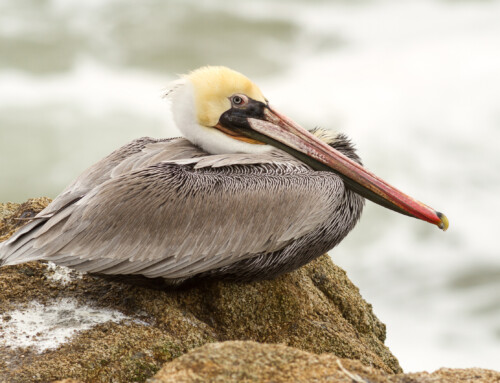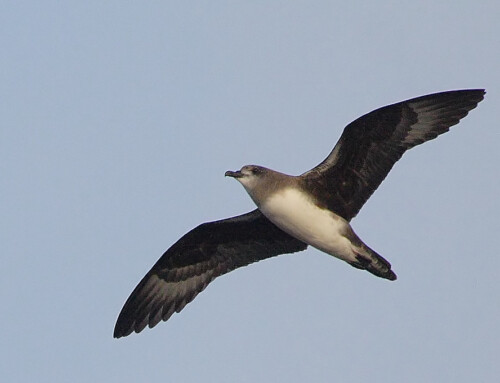 Can a bird use dynamic soaring in a steady homogenous wind?
Can a bird use dynamic soaring in a steady homogenous wind?
Colin Taylor’s website and his BOU blog article ‘Dynamic Soaring‘ both argue that energy-neutral soaring flight can be achieved by a bird flying in a steady homogenous horizontal wind.
To my mind dynamic soaring is a technique in which birds exploit the vertical gradient of wind velocity (wind shear) and also temporal variations of wind velocity for sustained energy-neutral soaring (see references below). In this technique a bird climbs up across the wind shear layer headed into the wind, turns and descends down across the wind shear layer headed downwind, and then turns to head upwind again. Albatrosses are known to use dynamic soaring to fly very long distances without flapping their wings.
There are no documented studies of albatrosses using a steady homogenous horizontal wind for sustained soaring, which raises questions about how energy could be gained in Taylor’s Windward Turn Theory. In order to try to understand this, I carefully read material in the website and discussed it with Colin Taylor.
In the following, I summarize problems with the Windward Turn Theory that invalidate its conclusion about energy-neutral flight.
The main point is that if one assumes a steady homogenous horizontal wind then sustained soaring cannot be achieved. This is because documented mechanisms for energy-neutral soaring are excluded. Specifically, a homogenous wind excludes gradients of the wind velocity (wind shear), a steady wind excludes temporal variations (wind gusts), and a horizontal wind excludes updrafts. Thus, dynamic soaring is excluded as is soaring using updrafts. Therefore, the answer to the question posed in the title must be no.
The shortcomings of the Theory are briefly discussed below. In this discussion drag is assumed to be negligible. This simplifies the physics since drag always reduces energy, and by assuming that drag is zero one can calculate energy gained from flight maneuvers. A second assumption is that total energy, consisting of kinetic energy (KE) plus potential energy (PE), remains constant for a bird in flight. A third assumption is that in the following the term ‘wind- means a steady homogenous horizontal movement of the air.
There are two main flaws in the Windward Turn Theory. The first is that it uses the velocity of the bird relative to the ground (ground velocity) in the calculation of KE, which is then incorrectly assumed to balance PE. A bird’s ground velocity (or ground speed) is the sum of the bird’s velocity through the air (airspeed) and the wind velocity. Airspeed is the usual and correct term in calculating KE in the balance with PE in soaring flight. This can be seen in the example of a bird accelerating as it glides downward. The bird’s airspeed increases accelerated by gravity, and height decreases. As sailplane pilots describe it, height is traded for airspeed. The trade is not linear since airspeed is squared to calculate kinetic energy, and drag must be ignored. The wind has nothing to do with the balance between airspeed KE and PE. There are many examples indicating why this is true.
Consider a bird flying in a level circle at constant airspeed in a wind. The bird’s ground speed increases when the bird turns and heads downwind. The increase in ground speed is due to the bird’s acceleration in a downwind direction caused by the lift force on the bird’s banked wings. The KE of the bird is increased by the work done by the wind on the bird (force times distance). In this case, the work is done by the downwind component of lift times the distance downwind that the bird is advected by the wind. As the bird turns upwind its ground speed and KE decrease due to the work done by the bird on the wind. The point is that the bird cannot gain or lose height in the turn as long as its airspeed remains constant despite large changes in ground speed KE.
A simpler formulation of the equations of motion would use a reference frame moving with the wind velocity. This eliminates wind from the solution and avoids the work of the wind on the bird, etc, as when using a reference frame attached to the ground. In this simpler case the balance between airspeed KE and PE is obvious.
The Windward Turn Theory incorrectly assumes that there is a height loss (loss of PE) when the bird turns downwind and its ground speed and ground speed KE increase. And the Theory incorrectly assumes that there is a height gain when the bird turns upwind and ground speed and ground speed KE decrease, despite the bird’s airspeed remaining constant in each turn. The use of ground speed in the calculation of total energy results in huge KE changes and corresponding unrealistically large apparent height changes, much larger than when airspeed KE balances PE. The Theory claims that there is a large increase in height as a bird turns from headed fast downwind to headed slowly upwindÔÇöthe windward turn of the Windward Turn Theory. However, this height is lost in the following leeward turn.
So, how could energy increase in the Theory since it excludes documented sources of energy? I believe that the Theory accidentally omits important terms in the energy equation or incorrectly calculates their values. As a test of this, I developed a model that simulates the Theory’s flight pattern of two linked 180 degree turns in a mean crosswind direction and incorporates the conservation of total energy using ground speed to calculate KE, which then balances PE (as in the Theory). My calculations found no net gain of energy in the Theory’s flight maneuver. I conclude that there is no net gain of energy and that the Theory cannot be used to explain energy-neutral soaring flight.
In summary, two mistakes resulted in an erroneous apparent energy gain in the Windward Turn Theory. The first is the use of ground speed to calculate KE, which is then incorrectly used to balance PE. The second is the incorrect calculation of energy terms in the Theory, which leads to an apparent net energy increase in the flight circuit. Without these mistakes, there is no net increase of energy in the Theory’s flight maneuver. Energy-neutral soaring flight is not possible in a steady homogenous horizontal wind since dynamic soaring is excluded as is soaring using updrafts.
References
Deittert, M., A. Richards, C. A. Toomer, A. Pipe, 2009: Engineless UAV propulsion by dynamic soaring, Journal of Guidance, Control, and Dynamics, 32 (5), 1446-1457.
Lissaman, P., 2005. Wind energy extraction by birds and flight vehicles. American Institute of Aeronautics and Astronautics Paper 2005-241, January 2005.
Rayleigh, J. W. S., 1883. The soaring of birds. Nature 27, 534-535.
Richardson, P. L., 2011: How do albatrosses fly around the world without flapping their wings? Progress in Oceanography 88, 46-58.
Sachs, G., 2005. Minimum shear wind strength required for dynamic soaring of albatrosses. Ibis 147, 1-10.
Images: Cory’s Shearwater © Steve Dudley; Composite image of Black-browed Albatross and Kinetic 100 radio-controlled glider © Philip Richardson
Blog with #theBOUblog
If you want to write about your research in #theBOUblog, then please see here.






